Engage NY Eureka Math 7th Grade Module 3 Lesson 18 Answer Key
Eureka Math Grade 7 Module 3 Lesson 18 Example Answer Key
Example 1.
Find the area of the following semicircle. Use π ≈ \(\frac{22}{7}\) .
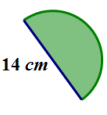
Answer:
If the diameter of the circle is 14 cm, then the
radius is 7 cm. The area of the semicircle is half
of the area of the circular region.
A ≈ \(\frac{1}{2}\) ∙ \(\frac{22}{7}\) ∙ (7 cm)2
A ≈ \(\frac{1}{2}\) ∙ \(\frac{22}{7}\) ∙ 49 cm2
A ≈ 77 cm2
What is the area of the quarter circle? Use π ≈ \(\frac{22}{7}\) .
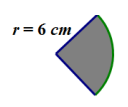
Answer:
A ≈ \(\frac{1}{4}\) ∙ \(\frac{22}{7}\) (6 cm)2
A ≈ \(\frac{1}{4}\) ∙ \(\frac{22}{7}\) ∙ 36 cm2
A ≈ \(\frac{198}{7}\) cm2
Example 2.
Marjorie is designing a new set of placemats for her dining room table. She sketched a drawing of the placement on graph paper. The diagram represents the area of the placemat consisting of a rectangle and two semicircles at either end. Each square on the grid measures 4 inches in length.
Find the area of the entire placemat. Explain your thinking regarding the solution to this problem.
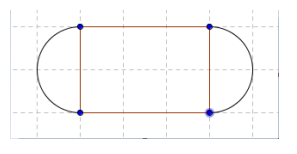
Answer:
The length of one side of the rectangular section is 12 inches in length, while the width is 8 inches. The radius of the semicircular region is 4 inches. The area of the rectangular part is (8 in) ∙ (12 in) = 96 in2. The total area must include the two semicircles on either end of the placemat. The area of the two semicircular regions is the same as the area of one circle with the same radius. The area of the circular region is A = π ∙ (4 in)2 = 16π in2. In this problem, using π ≈ 3.14 makes more sense because there are no fractions in the problem. The area of the semicircular regions is approximately 50.24 in2. The total area for the placemat is the sum of the areas of the rectangular region and the two semicircular regions, which is approximately (96+50.24) in2 = 146.24 in2.
If Marjorie wants to make six placemats, how many square inches of fabric will she need? Assume there is no waste.
Answer:
There are 6 placemats that are each 146.24 in2, so the fabric needed for all is 6 ∙ 146.24 in2 = 877.44 in2.
Marjorie decides that she wants to sew on a contrasting band of material around the edge of the placemats. How much band material will Marjorie need?
Answer:
The length of the band material needed will be the sum of the lengths of the two sides of the rectangular region and the circumference of the two semicircles (which is the same as the circumference of one circle with the same radius).
P = (l+l+2πr)
P = (12+12+2 ∙ π ∙ 4) = 49.12
The perimeter is 49.12 in2.
Example 3.
The circumference of a circle is 24π cm. What is the exact area of the circle?
Draw a diagram to assist you in solving the problem.
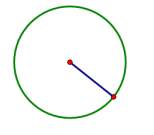
What information is needed to solve the problem?
Answer:
The radius is needed to find the area of the circle. Let the radius be r cm. Find the radius by using the circumference formula.
C = 2πr
24π = 2πr
(\(\frac{1}{2}\) π)24π = (\(\frac{1}{2}\) π)2πr
12 = r
The radius is 12 cm.
Next, find the area.
Answer:
A = π r2
A = π(12)2
A = 144π
The exact area of the circle is 144π cm2.
Eureka Math Grade 7 Module 3 Lesson 18 Exercise Answer Key
Opening Exercise
Draw a circle with a diameter of 12 cm and a square with a side length of 12 cm on grid paper. Determine the area of the square and the circle.
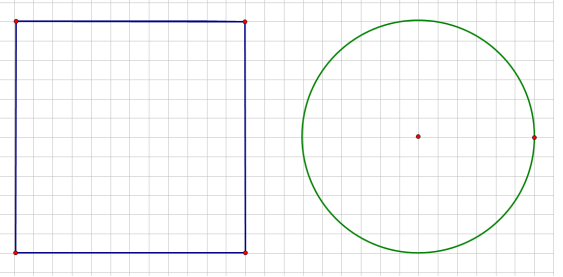
Answer:
Area of square: A = (12 cm)2 = 144 cm2; Area of circle: A = π ∙ (6 cm)2 = 36π cm2
Brainstorm some methods for finding half the area of the square and half the area of the circle.
Answer:
Some methods include folding in half and counting the grid squares and cutting each in half and counting the squares.
Find the area of half of the square and half of the circle, and explain to a partner how you arrived at the area.
Answer:
The area of half of the square is 72 cm2. The area of half of the circle is 18π cm2. Some students may count the squares; others may realize that half of the square is a rectangle with side lengths of 12 cm and 6 cm and use A = l ∙ w to determine the area. Some students may fold the square vertically, and some may fold it horizontally. Some students will try to count the grid squares in the semicircle and find that it is easiest to take half of the area of the circle.
What is the ratio of the new area to the original area for the square and for the circle?
Answer:
The ratio of the areas of the rectangle (half of the square) to the square is 72:144 or 1:2. The ratio for the areas of the circles is 18π:36π or 1:2.
Find the area of one – fourth of the square and one – fourth of the circle, first by folding and then by another method. What is the ratio of the new area to the original area for the square and for the circle?
Answer:
Folding the square in half and then in half again will result in one – fourth of the original square. The resulting shape is a square with a side length of 6 cm and an area of 36 cm2. Repeating the same process for the circle will result in an area of 9π cm2. The ratio for the areas of the squares is 36:144 or 1:4. The ratio for the areas of the circles is 9π:36π or 1:4.
Write an algebraic expression that expresses the area of a semicircle and the area of a quarter circle.
Answer:
Semicircle: A = \(\frac{1}{2}\) πr2; Quarter circle: A = \(\frac{1}{4}\) πr2
Exercise 1.
Find the area of a circle with a diameter of 42 cm. Use π ≈ \(\frac{22}{7}\) .
Answer:
If the diameter of the circle is 42 cm, then the radius is 21 cm .
A = πr2
A ≈ \(\frac{22}{7}\) (21 cm)2
A ≈ 1386 cm2
Exercise 2.
The circumference of a circle is 9π cm.
a. What is the diameter?
Answer:
If C = πd, then 9π cm = πd.
Solving the equation for the diameter, d, \(\frac{1}{\pi}\) ∙ 9π cm = \(\frac{1}{\pi}\) π ∙ d.
So, 9 cm = d.
b. What is the radius?
Answer:
If the diameter is 9 cm, then the radius is half of that or \(\frac{9}{2}\) cm.
c. What is the area?
Answer:
The area of the circle is A = π ∙ (\(\frac{9}{2}\) cm)2, so A = \(\frac{81}{4}\) π cm2.
Exercise 3.
If students only know the radius of a circle, what other measures could they determine? Explain how students would use the radius to find the other parts.
Answer:
If students know the radius, then they can find the diameter. The diameter is twice as long as the radius. The circumference can be found by doubling the radius and multiplying the result by π. The area can be found by multiplying the radius times itself and then multiplying that product by π.
Exercise 4.
Find the area in the rectangle between the two quarter circles if AF = 7 ft, FB = 9 ft, and HD = 7 ft. Use π ≈ \(\frac{22}{7}\) . Each quarter circle in the top – left and lower – right corners have the same radius.
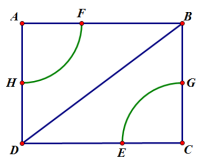
Answer:
The area between the quarter circles can be found by subtracting the area of the two quarter circles from the area of the rectangle. The area of the rectangle is the product of the length and the width. Side AB has a length of 16 ft and Side AD has a length of 14 ft. The area of the rectangle is
A = 16 ft ∙ 14 ft = 224 ft2. The area of the two quarter circles is the same as the area of a semicircle, which is half the area of a circle. A = \(\frac{1}{2}\) πr2.
A ≈ \(\frac{1}{2}\) ∙ \(\frac{22}{7}\) ∙ (7 ft)2
A ≈ \(\frac{1}{2}\) ∙ \(\frac{22}{7}\) ∙ 49 ft2
A ≈ 77 ft2
The area between the two quarter circles is 224 ft2 – 77 ft2 = 147 ft2.
Eureka Math Grade 7 Module 3 Lesson 18 Problem Set Answer Key
Question 1.
Mark created a flower bed that is semicircular in shape. The diameter of the flower bed is 5 m .
a. What is the perimeter of the flower bed? (Approximate π to be 3.14.)
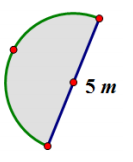
Answer:
The perimeter of this flower bed is the sum of the diameter and one – half the circumference of a circle with the same diameter.
P = diameter+\(\frac{1}{2}\) π ∙ diameter
P ≈ 5 m+\(\frac{1}{2}\) ∙ 3.14 ∙ 5 m
P ≈ 12.85 m
b. What is the area of the flower bed? (Approximate π to be 3.14.)
Answer:
A = \(\frac{1}{2}\) π (2.5 m)2
A = \(\frac{1}{2}\) π (6.25 m2)
A ≈ 0.5 ∙ 3.14 ∙ 6.25 m2
A ≈ 9.8 m2
Question 2.
A landscape designer wants to include a semicircular patio at the end of a square sandbox. She knows that the area of the semicircular patio is 25.12 cm2.
a. Draw a picture to represent this situation.
Answer:
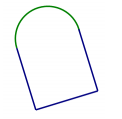
b. What is the length of the side of the square?
Answer:
If the area of the patio is 25.12 cm2, then we can find the radius by solving the equation A = \(\frac{1}{2}\) πr2 and substituting the information that we know. If we approximate π to be 3.14 and solve for the radius, r, then
25.12 cm2 ≈ \(\frac{1}{2}\) πr2
\(\frac{2}{1}\) ∙ 25.12 cm2 ≈ \(\frac{2}{1}\) ∙ \(\frac{1}{2}\) πr2
50.24 cm2 ≈ 3.14r2
\(\frac{1}{3.14}\) ∙ 50.24 cm2 ≈ \(\frac{1}{3.14}\) ∙ 3.14r2
16 cm2 ≈ r2
4 cm ≈ r
The length of the diameter is 8 cm; therefore, the length of the side of the square is 8 cm.
Question 3.
A window manufacturer designed a set of windows for the top of a two – story wall. If the window is comprised of 2 squares and 2 quarter circles on each end, and if the length of the span of windows across the bottom is 12 feet, approximately how much glass will be needed to complete the set of windows?

Answer:
The area of the windows is the sum of the areas of the two quarter circles and the two squares that make up the bank of windows. If the span of windows is 12 feet across the bottom, then each window is 3 feet wide on the bottom. The radius of the quarter circles is 3 feet, so the area for one quarter circle window is A = \(\frac{1}{4}\) π ∙ (3 ft)2, or A ≈ 7.065 ft2. The area of one square window is A = (3 ft)2, or 9 ft2. The total area is A = 2(area of quarter circle)+2(area of square), or A ≈ (2 ∙ 7.065 ft2 )+(2 ∙ 9 ft2 ) ≈ 32.13 ft2.
Question 4.
Find the area of the shaded region. (Approximate π to be \(\frac{22}{7}\) .)
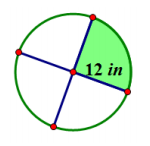
Answer:
A = \(\frac{1}{4}\) π(12 in)2
A = \(\frac{1}{4}\) π ∙ 144 in2
A ≈ \(\frac{1}{4}\) ∙ \(\frac{22}{7}\) ∙ 144 in2
A ≈ 792/7 in2 or 113.1 in2
Question 5.
The figure below shows a circle inside of a square. If the radius of the circle is 8 cm, find the following and explain your solution.
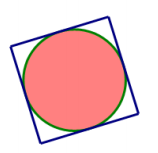
a. The circumference of the circle
Answer:
C = 2π ∙ 8 cm
C = 16π cm
b. The area of the circle
Answer:
A = π ∙ (8 cm)2
A = 64 π cm2
c. The area of the square
Answer:
A = 16 cm ∙ 16 cm
A = 256 cm2
Question 6.
Michael wants to create a tile pattern out of three quarter circles for his kitchen backsplash. He will repeat the three quarter circles throughout the pattern. Find the area of the tile pattern that Michael will use. Approximate π as 3.14.
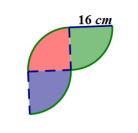
Answer:
There are three quarter circles in the tile design. The area of one quarter circle multiplied by 3 will result in the total area.
A = \(\frac{1}{4}\) π ∙ (16 cm)2
A ≈ \(\frac{1}{4}\) ∙ 3.14 ∙ 256 cm2
A ≈ 200.96 cm2
A ≈ 3 ∙ 200.96 cm2
A ≈ 602.88 cm2
The area of the tile pattern is approximately 602.88 cm2.
Question 7.
A machine shop has a square metal plate with sides that measure 4 cm each. A machinist must cut four semicircles with a radius of \(\frac{1}{2}\) cm and four quarter circles with a radius of 1 cm from its sides and corners. What is the area of the plate formed? Use \(\frac{22}{7}\) to approximate π.
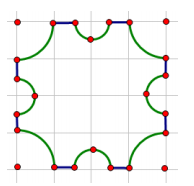
Answer:
The area of the metal plate is determined by subtracting the four quarter circles (corners) and the four half – circles (on each side) from the area of the square. Area of the square: A = (4 cm)2 = 16 cm2.
The area of four quarter circles is the same as the area of a circle with a radius of
1 cm: A ≈ \(\frac{22}{7}\) (1 cm)2 ≈ \(\frac{22}{7}\) cm2.
The area of the four semicircles with radius \(\frac{1}{2}\) cm is
A ≈ 4 ∙ \(\frac{1}{2}\) ∙ \(\frac{22}{7}\) ∙ (\(\frac{1}{2}\) cm)2
A ≈ 4 ∙ \(\frac{1}{2}\) ∙ \(\frac{22}{7}\) ∙ \(\frac{1}{4}\) cm2 ≈ 11/7 cm2.
The area of the metal plate is
A ≈ 16 cm2 – \(\frac{22}{7}\) cm2 – \(\frac{11}{7}\) cm2 ≈ \(\frac{79}{7}\) cm2
Question 8.
A graphic artist is designing a company logo with two concentric circles (two circles that share the same center but have different radii). The artist needs to know the area of the shaded band between the two concentric circles. Explain to the artist how he would go about finding the area of the shaded region.
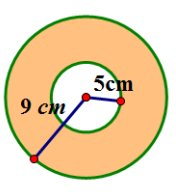
Answer:
The artist should find the areas of both the larger and smaller circles. Then, the artist should subtract the area of the smaller circle from the area of the larger circle to find the area between the two circles. The area of the larger circle is
A = π ∙ (9 cm)\(\frac{22}{7}\) or 81π cm\(\frac{22}{7}\) .
The area of the smaller circle is
A = π(5 cm)\(\frac{22}{7}\) or 25π cm\(\frac{22}{7}\) .
The area of the region between the circles is 81π cm\(\frac{22}{7}\) – 25π cm\(\frac{22}{7}\) = 56π cm\(\frac{22}{7}\) . If we approximate π to be 3.14, then A ≈ 175.84 cm\(\frac{22}{7}\) .
Question 9.
Create your own shape made up of rectangles, squares, circles, or semicircles, and determine the area and perimeter.
Answer:
Student answers may vary.
Eureka Math Grade 7 Module 3 Lesson 18 Exit Ticket Answer Key
Question 1.
Ken’s landscape gardening business creates odd – shaped lawns that include semicircles. Find the area of this semicircular section of the lawn in this design. Use \(\frac{22}{7}\) for π.
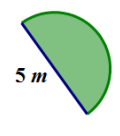
Answer:
If the diameter is 5 m, then the radius is \(\frac{5}{2}\) m. Using the formula for area of a semicircle, A = \(\frac{1}{2}\) πr2, A ≈ \(\frac{1}{2}\) ∙ \(\frac{22}{7}\) ∙ (\(\frac{5}{2}\) m)2. Using the order of operations,
A ≈ \(\frac{1}{2}\) ∙ \(\frac{22}{7}\) ∙ \(\frac{25}{4}\) m2 ≈ \(\frac{550}{56}\) m2 ≈ 9.8 m2.
Question 2.
In the figure below, Ken’s company has placed sprinkler heads at the center of the two small semicircles. The radius of the sprinklers is 5 ft. If the area in the larger semicircular area is the shape of the entire lawn, how much of the lawn will not be watered? Give your answer in terms of π and to the nearest tenth. Explain your thinking.
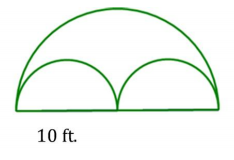
Answer:
The area not covered by the sprinklers would be the area between the larger semicircle and the two smaller ones. The area for the two semicircles is the same as the area of one circle with the same radius of 5 ft. The area not covered by the sprinklers can be found by subtracting the area of the two smaller semicircles from the area of the large semicircle.
Area Not Covered = Area of large semicircle – Area of two smaller semicircles
A = \(\frac{1}{2}\) π ∙ (10 ft)2 – (2 ∙ (\(\frac{1}{2}\) (π ∙ (5 ft)2 )))
A = \(\frac{1}{2}\) π ∙ 100 ft2 – π ∙ 25 ft2
A = 50π ft2 – 25π ft2 = 25π ft2
Let π ≈ 3.14
A ≈ 78.5 ft2
The sprinklers will not cover 25π ft2 or 78.5 ft2 of the lawn.